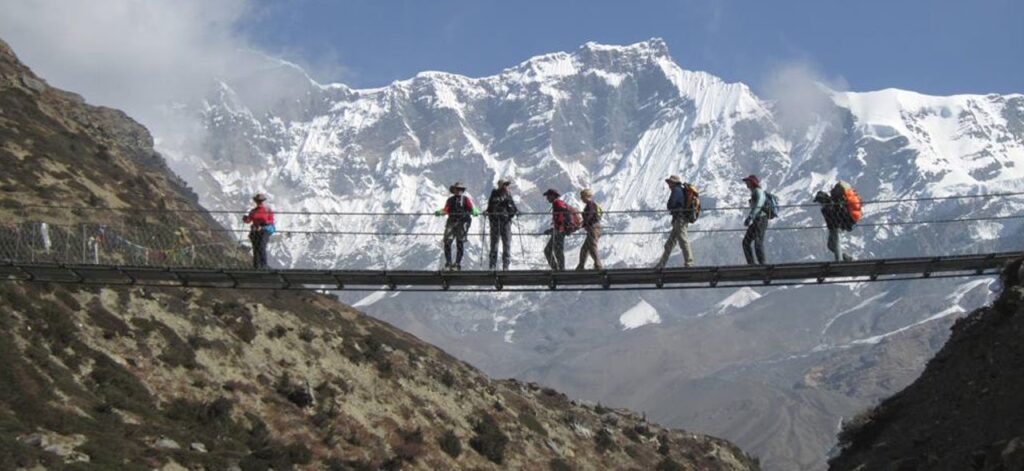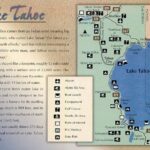The Annapurna Circuit Trek is renowned for being one of the most spectacular and diverse trekking routes in the world. This classic trek in Nepal, stretching approximately 160-230 kilometers depending on the exact route taken, offers a remarkable journey through a range of ecosystems, cultures, and landscapes. From lush subtropical forests and terraced fields to high-altitude deserts and snow-capped peaks, the Annapurna Circuit is a bucket-list adventure for many trekkers. However, to make the most of this once-in-a-lifetime experience, thorough preparation is essential. Here’s how to gear up for this ultimate adventure:
1. Physical Preparation
The Annapurna Circuit Trek demands a good level of physical fitness due to its variable terrain and high altitudes. Begin training at least 3-4 months before your trek. Incorporate cardiovascular exercises such as running, cycling, or swimming to build stamina. Strengthen your legs with exercises like squats, lunges, and step-ups to prepare for the uphill and downhill sections. Additionally, practice hiking with a loaded backpack to simulate trek conditions. Aim for long hikes of 4-6 hours to build endurance and get accustomed to extended periods on your feet.
2. Acclimatization and Altitude Sickness
The trek reaches an altitude of over 5,400 meters (17,700 feet) at the Thorong La Pass, making acclimatization crucial. To minimize the risk of altitude sickness, ascend slowly and follow the rule of gaining no more than 500 meters (1,640 feet) per day above 3,000 meters (9,840 feet). Spend extra days at key points such as Manang to acclimatize. Hydration is essential; drink plenty of water and consider carrying electrolytes to maintain balance.
3. Gear and Packing
Proper gear is vital for a successful trek. Invest in high-quality trekking boots that offer good ankle support and have been broken in before the trek. Layered clothing is important to adapt to the changing weather; pack moisture-wicking base layers, insulating mid-layers, and a waterproof, windproof outer layer. A sturdy trekking pole can help with stability, particularly on steep or uneven terrain. Other essentials include a good sleeping bag rated for cold temperatures, a tent (if not staying in teahouses), a first-aid kit, and sun protection like sunglasses and sunscreen.
4. Permits and Regulations
To trek the Annapurna Circuit, you’ll need several permits. The Annapurna Conservation Area Permit (ACAP) and the TIMS (Trekkers’ Information Management System) card are mandatory. Obtain these permits in advance through a registered trekking agency or at the Nepal Tourism Board in Kathmandu or Pokhara. Ensure you also check the latest regulations and requirements as these can change.
5. Health and Safety
Consult your doctor before embarking on the trek, especially if you have pre-existing health conditions. Vaccinations for Hepatitis A and B, Typhoid, and Tetanus are recommended. Carry a basic first-aid kit including medications for common issues such as altitude sickness, digestive problems, and pain relief. Be aware of the symptoms of altitude sickness—headaches, dizziness, nausea—and be prepared to descend if necessary.
6. Cultural Sensitivity
The Annapurna Circuit passes through various ethnic villages, each with its unique customs and traditions. Respect local cultures and practices; dress modestly and seek permission before taking photographs, particularly in religious areas. Engaging with local communities and learning about their traditions can enrich your trekking experience.
7. Mental Preparation
Finally, mentally prepare for the trek. The Annapurna Circuit is not just a physical challenge but also a test of endurance and patience. Be ready for unpredictable weather, potential delays, and the physical toll of high altitudes. Embrace the journey with a positive mindset, and savor the breathtaking landscapes and cultural encounters along the way.
Preparing for the Annapurna Circuit Trek involves more than just physical training and packing. It requires careful planning, respect for the environment and local cultures, and a readiness to face the challenges that come with high-altitude trekking. With the right preparation, you’ll be well-equipped to embark on this unforgettable adventure and create memories that will last a lifetime.
Understanding the Annapurna Circuit
The Annapurna Circuit Trek, located in Nepal’s Himalayas, is celebrated for its diverse landscapes and cultural richness. Covering approximately 160-230 kilometers, depending on the specific route, it circumnavigates the Annapurna Massif, offering trekkers a unique opportunity to experience a variety of environments, from subtropical forests and terraced fields to high-altitude deserts and snowy peaks.
The trek traditionally begins in Besisahar and concludes in Nayapul, though some variations are possible. It takes around 15-20 days to complete, depending on pace and acclimatization needs. Key highlights include crossing the Thorong La Pass, one of the highest trekking passes in the world at 5,416 meters (17,769 feet), and visiting the picturesque villages of Manang and Jomsom.
Trekkers will also experience diverse cultural encounters with various ethnic groups, including Gurung, Magar, and Thakali communities. The trek’s altitude and variable weather conditions necessitate proper preparation and acclimatization.
The Annapurna Circuit is renowned for its spectacular views of the Annapurna and Dhaulagiri ranges, making it a quintessential trek for adventurers seeking both natural beauty and cultural immersion. It offers a blend of challenging terrain and rewarding vistas, making it one of the most iconic trekking routes in the world.
Setting Your Trekking Goals
Setting clear goals for your Annapurna Circuit Trek is crucial for a successful and enjoyable experience. Start by defining your objectives: Are you aiming to complete the trek within a specific timeframe, to reach certain viewpoints, or to immerse yourself in local culture? Establishing these goals helps tailor your preparation and ensure you stay focused throughout the journey.
Consider your fitness level and time constraints. If you’re an experienced trekker, you might set a goal to complete the circuit within the shortest time possible. For beginners, a more manageable goal could be to enjoy the trek at a steady pace, allowing for ample acclimatization and exploration of the local culture.
Set realistic expectations for each day of the trek, considering factors such as altitude gain, distance, and weather conditions. It’s also beneficial to have backup plans in case of unforeseen circumstances like adverse weather or health issues.
Incorporating personal goals, such as improving your physical fitness or developing a deeper appreciation for Nepalese culture, can make the trek more fulfilling. Regularly revisit and adjust your goals as you prepare to ensure they remain attainable and aligned with your capabilities and aspirations.
Physical Training Regimen
A well-structured physical training regimen is essential for preparing for the Annapurna Circuit Trek, which demands both cardiovascular endurance and muscular strength. Begin your preparation at least 3-4 months in advance to build the necessary fitness level.
Start with cardiovascular exercises such as running, cycling, or swimming to enhance stamina and heart health. Aim for at least 3-4 sessions per week, gradually increasing intensity and duration. Incorporate hill or stair climbing to simulate the trek’s inclines and improve your climbing ability.
Strength training is equally important. Focus on exercises that build leg muscles, such as squats, lunges, and step-ups, as these will help with the uphill and downhill sections of the trek. Core strengthening exercises, like planks and sit-ups, will improve stability and balance.
Include hiking with a weighted backpack in your regimen to simulate the trek’s conditions. Aim for long hikes of 4-6 hours, progressively increasing the distance and elevation to build endurance.
Don’t neglect flexibility and recovery. Stretching and yoga can prevent injuries and aid in muscle recovery. Ensure you allow time for rest and recuperation between intense workouts to avoid overtraining and fatigue.
Essential Gear and Equipment
Having the right gear is vital for a successful 12 day Annapurna Circuit Trek. Proper preparation with essential equipment ensures safety, comfort, and an overall positive trekking experience.
Firstly, invest in high-quality trekking boots that offer excellent ankle support and are broken in before the trek. These boots should be comfortable and provide good traction on varied terrain.
Layered clothing is crucial to adapt to changing weather conditions. Pack moisture-wicking base layers, insulating mid-layers (like fleece or down jackets), and a waterproof, windproof outer shell.
A durable backpack with good suspension and adequate capacity for your personal items is essential. Additionally, a sleeping bag rated for cold temperatures is necessary for the higher altitudes where temperatures drop significantly.
Other vital gear includes a trekking pole for stability, a first-aid kit for emergencies, and sun protection such as sunglasses and sunscreen. A good-quality water bottle or hydration system, a headlamp or flashlight with extra batteries, and a compact, reliable stove for cooking are also recommended.
Ensure you carry a personal identification and necessary permits, such as the Annapurna Conservation Area Permit (ACAP) and TIMS card, which are required for the trek. Proper gear not only enhances safety but also contributes to a more enjoyable trekking experience.
Selecting the Right Footwear
Selecting the right footwear is crucial for the Annapurna Circuit Trek, where diverse terrain and varying weather conditions demand optimal comfort and support. The right trekking boots can significantly impact your overall trekking experience.
Opt for high-quality trekking boots designed for rugged terrain. Look for boots that offer strong ankle support, as the uneven and steep trails can put stress on your ankles. Ensure that the boots fit well; they should be snug but not tight, with enough room to accommodate thicker socks and prevent blisters.
Waterproofing is another essential feature. Given the potential for wet conditions, especially during the monsoon season or in snow, waterproof boots will keep your feet dry and comfortable. Breathability is also important to prevent excessive sweating and discomfort.
Consider the weight of the boots. Heavier boots offer more support and durability, but lighter options can reduce fatigue on long treks. Balance between weight and support based on your personal preference and the specific demands of the trek.
Test your boots thoroughly before the trek. Wear them on various terrains and distances to ensure they are broken in and comfortable. Properly fitted, well-constructed boots will enhance your stability and reduce the risk of injuries, making your Annapurna Circuit experience more enjoyable and safe.
Packing Strategies for the Trek
Effective packing is crucial for the Annapurna Circuit Trek to ensure comfort, safety, and efficiency. Begin by selecting a durable, lightweight backpack with adequate capacity (40-60 liters) to carry your essentials without overloading. Opt for a pack with good suspension and adjustable straps for even weight distribution.
When packing, use the layering system for clothing. Start with moisture-wicking base layers to keep sweat away from your skin, add insulating mid-layers like fleece or down jackets for warmth, and finish with a waterproof, windproof outer shell to protect against the elements. Pack lightweight, quick-drying clothes to adapt to varying temperatures.
Include essential items such as a high-quality sleeping bag rated for cold temperatures, trekking poles for stability, and a lightweight, durable tent if not staying in teahouses. Don’t forget a headlamp with extra batteries, a multi-tool, and a first-aid kit for emergencies.
Hydration is key, so carry a reliable water bottle or hydration system, along with water purification tablets or a filter. Sunscreen, sunglasses, and lip balm with high SPF are crucial for sun protection at high altitudes.
Organize your gear using packing cubes or dry bags to keep items easily accessible and dry. Remember to pack snacks and high-energy food items to keep your energy levels up during the trek. Efficient packing not only ensures you have everything you need but also contributes to a more comfortable and enjoyable trekking experience.
Health and Safety Precautions
Health and safety are paramount on the Annapurna Circuit Trek, given the challenging terrain and high-altitude conditions. Before embarking on the trek, consult with a healthcare provider to discuss any pre-existing conditions and get recommendations for necessary vaccinations. Vaccinations for Hepatitis A and B, Typhoid, and Tetanus are generally advised.
Altitude sickness is a significant concern, as the trek reaches heights exceeding 5,400 meters (17,700 feet). To mitigate this risk, ascend gradually and adhere to the recommended altitude gain of no more than 500 meters (1,640 feet) per day above 3,000 meters (9,840 feet). Carry medication for altitude sickness, such as Diamox, and be aware of symptoms like headaches, nausea, and dizziness.
Maintain good hygiene to prevent gastrointestinal issues; drink purified water, avoid consuming unwashed fruits and vegetables, and use hand sanitizer regularly. A well-stocked first-aid kit is essential, including medications for common ailments like headaches, digestive issues, and pain relief.
Lastly, ensure you have adequate insurance coverage that includes high-altitude trekking and emergency evacuation. Safety should be a top priority to ensure a smooth and enjoyable trekking experience.
Acclimatization Tips
Proper acclimatization is crucial for tackling the Short Annapurna Circuit Trek, as the high altitudes pose risks of altitude sickness. To acclimate effectively, follow the principle of gradual ascent. Increase your altitude slowly, ideally gaining no more than 300-500 meters (1,000-1,600 feet) per day above 3,000 meters (9,840 feet).
Incorporate acclimatization days into your trek, particularly in areas like Manang or Thorong Phedi, where you can rest and adjust to the elevation. During these days, engage in light activities like short hikes or exploration to aid acclimatization while minimizing altitude-related risks.
Stay well-hydrated to help your body adjust to the higher elevations. Aim to drink at least 3-4 liters of water per day, and consider using hydration tablets to maintain electrolyte balance. Avoid alcohol and caffeine, as they can contribute to dehydration.
Pay attention to your body and be aware of symptoms of altitude sickness, such as headaches, nausea, or dizziness. If symptoms persist or worsen, descend to a lower altitude immediately and seek medical attention if necessary.
By planning your trek with ample acclimatization time and listening to your body, you can reduce the risk of altitude-related issues and enjoy a more comfortable trekking experience.
Understanding the Weather Conditions
Understanding the weather conditions is essential for planning and preparing for the Annapurna Circuit Trek. The trek’s weather varies significantly due to its diverse altitudes and geographical features. Generally, the best times for trekking are pre-monsoon (March to May) and post-monsoon (September to November), when weather conditions are relatively stable and visibility is clear.
During these periods, temperatures can range from 15°C (59°F) at lower altitudes to below -10°C (14°F) at higher elevations, such as Thorong La Pass. However, temperatures can drop further at night, especially in higher regions, so be prepared for cold conditions.
In the monsoon season (June to August), the region experiences heavy rainfall, which can lead to slippery trails and increased risk of landslides. Snowfall is also common in the winter months (December to February), making the trails potentially hazardous and the trek more challenging.
Check the weather forecast regularly before and during your trek. Be prepared for sudden weather changes by packing appropriate clothing and gear, including a waterproof, windproof jacket, and warm layers. Being adaptable and ready for varying weather conditions ensures a safer and more enjoyable trekking experience.
Finding and Booking Accommodations
Finding and booking accommodations for the Annapurna Circuit Trek involves understanding the available options and making arrangements that suit your needs and preferences. The trek primarily offers two types of accommodations: teahouses and camping.
Teahouses, which are small lodges or guesthouses located along the trekking route, provide basic but comfortable lodging. They offer amenities such as a bed, blankets, and often meals, making them a popular choice for trekkers. Booking teahouses in advance is recommended during peak trekking seasons to ensure availability, though in less busy times, you may find accommodations without prior reservations.
For those preferring a more adventurous experience, camping is another option. If you choose to camp, you will need to carry a tent, sleeping bag, and other camping gear. Hiring a trekking agency that provides camping services can simplify this process, as they offer equipment and support throughout the trek.
Regardless of your choice, consider the location of accommodations in relation to key points on the trek and ensure they offer facilities to meet your needs, such as clean restrooms and access to hot meals. It’s also wise to check recent reviews and recommendations to ensure the quality and safety of your chosen accommodations.
Proper planning and early booking of accommodations will enhance your trekking experience, ensuring comfort and allowing you to focus on enjoying the stunning Annapurna Circuit.
Managing Your Budget
Managing your budget for the Annapurna Circuit Trek requires careful planning to ensure you have sufficient funds for both expected and unexpected expenses. The cost of the trek can vary significantly depending on several factors including the duration, style of trek, and personal preferences.
Permits and Fees: The primary permits required are the Annapurna Conservation Area Permit (ACAP) and the TIMS (Trekkers’ Information Management System) card. These typically cost around USD 30-50 each. Ensure you budget for these in advance.
Trekking Agency Costs: If you opt for a guided trek or require a porter, costs will be higher. Guided treks can range from USD 1,000 to 2,000 depending on the level of service, group size, and additional amenities. Porters usually cost about USD 15-25 per day.
Accommodation and Meals: Teahouse stays are relatively affordable, with nightly rates ranging from USD 5-20 depending on the location and facilities. Meals cost around USD 5-10 per meal. In higher altitudes, prices can increase.
Gear and Equipment: If you need to rent or purchase gear, such as trekking boots or sleeping bags, account for these costs. Renting gear in Kathmandu or Pokhara can be cheaper than buying new.
Miscellaneous Expenses: Budget for additional costs such as tips for guides and porters, emergency expenses, and souvenirs. It’s prudent to carry some extra cash for unforeseen expenses.
In total, a moderate budget for a self-guided trek can range from USD 800 to 1,200, while a guided trek might cost USD 1,500 to 3,000. Proper budgeting ensures you’re well-prepared financially for a smooth trekking experience.
Food and Water Considerations
Food and water are critical components of the Annapurna Circuit Trek, impacting both your health and enjoyment. Proper planning ensures you stay hydrated and well-nourished throughout the trek.
Teahouse Meals: Most teahouses along the circuit offer a variety of meals. Expect to find a mix of local Nepalese dishes, such as dal bhat (rice and lentils), and international options like pasta or fried rice. Meals are generally nutritious, but quality can vary, so choose teahouses with good reviews.
Hydration: Safe drinking water is crucial. In teahouses, you can purchase bottled or boiled water. However, to minimize plastic use and save costs, consider using a water purification system like a filter or purification tablets. Always purify water sourced from streams or rivers.
High-Energy Snacks: Carry high-energy snacks such as nuts, trail mix, energy bars, and chocolate. These can provide quick energy boosts during long trekking days and serve as a backup if teahouse meals are not available or to your taste.
Dietary Restrictions: Inform your guide or check the menu in advance if you have specific dietary needs. While most teahouses can accommodate common dietary preferences, it’s best to confirm this beforehand.
Maintaining good hydration and nutrition is essential for sustaining energy levels and preventing altitude sickness, making careful planning of food and water a key aspect of a successful trek.
Navigational Tools and Resources
Proper navigation is vital for a successful Annapurna Circuit Trek, given the complex terrain and remote areas. Several tools and resources can aid in navigation and ensure you stay on the right track.
Maps and Guidebooks: Carry a detailed trekking map of the Annapurna Circuit and a reliable guidebook. Maps provide essential information on trail routes, elevations, and landmarks. Guidebooks offer valuable insights on accommodations, trail conditions, and cultural notes.
GPS Devices: A GPS device or a smartphone with GPS capabilities can be very useful. Many trekking apps provide detailed maps and real-time tracking. Ensure your device is fully charged and carry a power bank for extended use.
Local Guides: Hiring a local guide can enhance navigation and enrich your trekking experience with local knowledge. Guides are familiar with the terrain, weather conditions, and can provide assistance in case of emergencies.
Trail Markers: Pay attention to trail markers and signs along the route. While the Annapurna Circuit is well-trodden, markers can help confirm your path, especially in foggy or snowy conditions.
Community Advice: Engage with fellow trekkers and local residents for updates on trail conditions and navigation tips. Sharing information can provide real-time insights and enhance safety.
Effective navigation tools and resources ensure you stay on track, enhancing both safety and enjoyment throughout your Annapurna Circuit Trek.
Cultural Insights and Etiquette
Understanding and respecting the local culture and etiquette is important for a positive experience on the Annapurna Circuit Trek. The trek passes through diverse villages inhabited by various ethnic groups, each with their customs and traditions.
Respect for Local Customs: Be aware of and respect local customs and traditions. For instance, when visiting religious sites, dress modestly and remove your shoes before entering temples or monasteries.
Interaction with Locals: Greet locals with a friendly “Namaste” (a gesture of pressing your palms together). Show appreciation for their hospitality and cultural practices.
Photography Etiquette: Always ask for permission before taking photographs of people, especially in remote villages. Photography is generally welcomed but should be done respectfully.
Environmental Awareness: Follow the principles of Leave No Trace. Dispose of trash properly and avoid littering. Respect the natural environment and wildlife, minimizing your impact on the ecosystem.
Tipping Practices: Tipping is customary for guides and porters. A tip of 10-15% of the total trek cost is generally appropriate, depending on the level of service provided.
Adhering to cultural insights and etiquette fosters positive interactions with local communities and contributes to a more respectful and enriching trekking experience.
Final Preparations and Checklist
Before setting out on the Annapurna Circuit Trek, thorough final preparations ensure a smooth and enjoyable adventure. A well-organized checklist helps you cover all necessary aspects.
Documentation: Ensure you have all required permits (ACAP and TIMS), a valid passport, travel insurance, and any necessary vaccinations. Keep copies of these documents in a separate location in case of loss.
Gear Check: Verify that all your trekking gear, including clothing, footwear, and equipment, is in good condition and packed. Double-check essentials such as your backpack, sleeping bag, trekking poles, and headlamp.
Health Preparations: Confirm that you have sufficient medications, a first-aid kit, and any altitude sickness medication. Review health and safety guidelines and ensure you’re aware of symptoms of altitude sickness.
Travel Arrangements: Finalize your travel plans, including flights to and from Nepal, and transportation to the trek start point. Confirm accommodation bookings if not trekking independently.
Cash and Payment: Ensure you have enough local currency (Nepalese Rupees) for expenses along the trek. Have a small amount of USD or EUR for emergencies.
Emergency Contacts: Compile a list of emergency contacts, including your trekking agency (if applicable), local emergency services, and contacts back home.
Conducting a thorough final check and preparation ensures that you are well-equipped and organized for the 15 Days Trek to Annapurna Circuit, allowing you to focus on enjoying the journey and the stunning landscapes.







